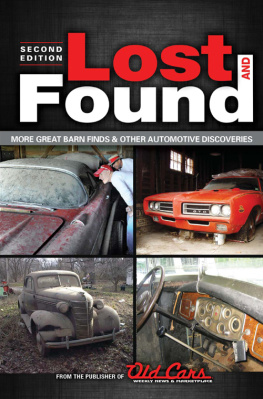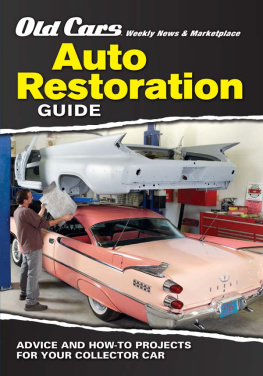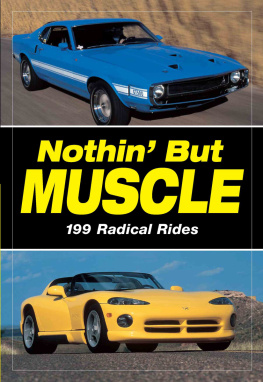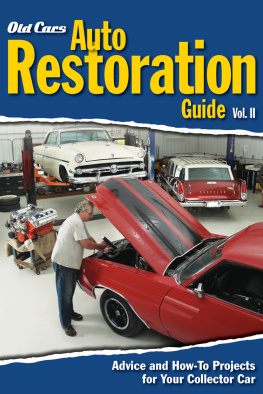How does it continue to happen? How do we keep coming across old cars that have been kept out of sight and out of mind for years, decades and even generations?
It seems impossible that a Duesenberg or Packard or expensive muscle car could have ever been locked away in a shed or barn, or forgotten in a field, and left unmolested for years. Sometimes, they almost hide in plain sight.
But make no mistake, great barn finds are still out there both ordinary, everyman cars and great Classics. Sometimes, they are right under our noses, and all it takes is a phone call, the courage to walk up and knock on the right door, or the luck to know a guy who knows a guy.
If youre one of those automobile lovers who cant drive by an old garage, barn or shed without thinking to yourself, I wonder if theres an old car in there? then this book is for you.
CHAPTER ONE 1922 DUESENBERG A702 ROADSTER
By Angelo Van Bogart
A DEUSY OF A HOT ROD
After being secretly stashed away for more than 60 years, an
amazing Duesenberg custom is headed for the street again

This Duesenberg Model A with engine A702 was recently pulled from the
California garage where it had rested since 1944. The Duesenbergs chassis was shortened
and fitted with a 1928 Chrysler roadster body before 1934. Thats a 1931 Graham radiator
shell, 1931 Chrysler headlamps and a Lincoln front bumper.
L ong before customs cruised with overhead-valve Rocket Eights and hot rods hustled under Ford flathead power, and even earlier than the period when hopped-up Ford Model A four-cylinders began kicking up salt on the flats, there was a different power of the hour. This power source was derived straight from Indy race cars and installed into passenger cars by 1921. After their time in street cars, many of these used engines were put back into race cars and returned to Indy to add to the legend of Duesenberg.
Yes, Duesenberg was the source of one of, if not the hottest, powerplant during the 1920s. Its Model A passenger cars of the period used an overhead-cam straight-eight of 260 cubic inches that produced 90-100 hp at 3,000 rpm, good for 90 mph in high gear and 20 mpg in 1921.
With such power, its no surprise that Duesenberg passenger car engines were recycled in Indy cars through the early 1930s, and at least one Model A became the foundation for a modified roadster that may just slide the time line back for hot rodding.
It looks like a high boy, said Randy Ema, an automotive historian and restorer who specializes in Duesenberg, and the owner of the modified Model A roadster shown here.
In November 2010, Ema pulled his shortened, cycle-fendered 1922 Duesenberg roadster out of a Burbank, Calif., garage, where it had rested since 1944.
I have known of the car for probably 30 years, Ema said. I used to visit [the owner Wil Johnson] and he actually showed me the car once. He just opened the garage and said, Did you see it? Thats how I saw it; that was it. He never let me go in.

The Duesenberg had been treated like anything but a treasure in its previous life. For years it
served as a storage shelf for other miscellaneous garage objects.

The body still retains the charcoal paint and silver moldings that were sprayed in
1934 or earlier, but traces of the Chrysler bodys original yellow paint and
rumble seat upholstery remain intact.
Emas view of the Duesenberg was obscured by piles of debris that covered the top of the car in its dark tomb. Since World War II, the car had served as a cumbersome shelf for a baby stroller, golf clubs, cardboard boxes and parts for the other interesting cars Johnson had collected.
The problem was, he told everyone it was an original Model A roadster, and I think he was afraid to let anybody who knew cars see it, Ema said. Even his next-door neighbor, who collected [Ford] Model As, never knew he had cars in there.
During its long slumber, the modified Duesenberg roadster had good company. Its longtime owner had amassed Lincoln Continentals from the 1940s, and at one time, had five Duesenbergs four Model As and the Model X Locke-bodied sedan previously featured in Old Cars Weekly. When Johnson died about 10 years ago, his family began selling his collection, and until late 2010, all but the Duesenberg roadster had been sold. However, Ema was able to learn much of the cars history from earlier conversations with Johnson and his daughter, and from files of the owner and those Ema has acquired elsewhere.
[Johnson] was an old engineer and he used to drive this thing to Douglas Aircraft in the 1940s, Ema said. He bought it in 1934 in Chicago and paid $650 for it from a guy who had a Stutz and Duesenberg business; it was later [John] Trokas dealership in 38 or 39.
He bought it in June of 34 for $650, and that was more than a Ford. It was probably a fresh car it had to have looked pretty damn spiffy, and it would have had to for him to pay that kind of money.
Johnson certainly received his moneys worth from the Duesenberg. The car provided 10 years of service from 1934 to 1944, which included a drive from Chicago to California. He drove this one from Chicago, when he came west the first time, Ema said. Were not sure if it was 1938 or 1940.
After the long drive, the car continued to provide sporting transportation for several more years, through most of World War II. The open-air fun ended in 1944, when the racy cars rear-end apparently went out. It was then parked and never driven again during the 20th century. When a car broke down, he parked it, he didnt fix it, Ema said of Johnson.

The Duesenberg retains its original instruments, but the panel behind
them was fashioned to fit the Chrysler body.
In November 2010, Ema pulled his shortened,
cycle-fendered 1922 Duesenberg roadster
out of a Burbank, Calif., garage, where it had
rested since 1944.
As a restorer, Emas mission is to make the roadster drive again, but hes doing his homework before tearing into the car. His first task is determining the components used to modify the car.
I did know that it was a steel body, Ema said. I thought for a long time it was a Gardner body. A friend of mine put it on the AACA [forum] and someone said that its a 28 Chrysler.
With this lead and through his own vast automotive knowledge, Ema has been able to determine the sources for many of the cars other non-Duesenberg components.
The rear fenders are from the Chrysler roadster, but I dont know what the hood is off, Ema said. The front fenders, I dont know what they are off, [but] the front bumper is Lincoln. The Model A [Duesenberg] radiator is underneath a 1931 Graham radiator screwed over the top. The headlights are 1931 Chrysler, so I am assuming this car was done in 1932 or 33.










